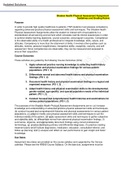Updated Solutions
Shadow Health Physical Assessment Assignment
Guidelines and Grading Rubric
Purpose
In order to provide high quality healthcare to patients, FNP students must possess competency
regarding advanced practice physical assessment skills and techniques. The Shadow Health
Physical Assessment Assignments allow the student to interact with virtual patients in a
standardized virtual learning environment which simulates real life clinical experiences in order
to achieve weekly learning objectives, course outcomes, and program outcomes. Competence
is the observable ability of a health professional to integrate knowledge, skills, values, and
attitudes. Competency is more than the attainment of skills; it involves other qualities such as
attitudes, motives, personal insightfulness, interpretive ability, receptivity, maturity, and self-
assessment. Since competencies are observable, they can be measured and assessed to
ensure their acquisition.
Course Outcomes
These activities are guided by the following Course Outcomes (COs):
1. Apply advanced practice nursing knowledge to collecting health history
information and physical examination findings for various patient
populations. (PO 1, 2)
2. Differentiate normal and abnormal health history and physical examination
findings. (PO 1, 2)
3. Document health history and physical examination findings in a logical and
organized sequence. (PO 1, 2)
4. Adapt health history and physical examination skills to the developmental,
gender-related, age-specific, and special population needs of the individual
patient. (PO 1, 2)
5. Conduct focused and comprehensive health histories and examinations for
various patient populations. (PO 1, 2)
The purposes of the Shadow Health Physical Assessment Assignments are to: (a) increase
knowledge and understanding of advanced practice physical assessment skills and techniques,
(b) conduct focused and comprehensive histories and physical assessments for various patient
populations, (c) adapt or modify your physical assessment skills and techniques to suit the
individual needs of the patient, (d) apply assessment skills and techniques to gather subjective
and objective data, (e) differentiate normal from abnormal physical examination findings, (f)
summarize, organize, and appropriately document findings using correct professional
terminology, (g) practice developing primary and differential diagnoses, (h) practice creating
treatment plans which include diagnostics, medication, education, consultation/referral, and
follow-up planning; and (i) analyze and reflect on own performance to gain insight and foster
knowledge.
Due Dates
Assignment due dates are provided on the course syllabus and supported by the Canvas
calendar. Please see the NR509 Course Syllabus. On the date due, assignments must be
, Updated Solutions
completed by 11:59 p.m. MT. Assignments in Shadow Health are sequential and must be
completed in order. Students are not permitted to work ahead.
Total Points Possible: 50 Points
Preparing for the Activity and Guidelines
1. Before initiating any activity in Shadow Health, complete the required course weekly
readings and lessons as well as review the weekly pre-brief in Canvas
2. Complete the Shadow Health DCE Orientation (Week 1 only) on the Shadow
Health virtual learning platform (https://app.shadowhealth.com)
3. Review the Shadow Health Tips and Tricks resource
4. Complete the Shadow Health Concept Labs (Weeks 1, 2, 4, and 5) prior to
beginning the any physical assessment assignment
5. Gather subjective and objective data by completing an appropriate detailed health
history and physical examination for each physical assessment assignment (Weeks
1-7)
6. Critically appraise the findings as normal or abnormal
7. Summarize, organize, and appropriately document findings using correct
professional terminology in the embedded Electronic Medical Record (EMR)
embedded in Shadow Health
8. Based on the history and physical assessment findings, develop a primary or
differential diagnosis for the focused assessment assignments
9. Create treatment plans that include each of the following components for a
comprehensive treatment plan: diagnostics, medication, education,
consultation/referral, and follow-up planning
10. Complete the post activity assessment questions (if applicable) for each assignment
11. Complete the reflection questions following each physical assessment assignment
(see the NR509 Debriefing Session Guidelines and Grading Rubric regarding the
reflection question responses)
12. Students must achieve a minimum Digital Clinical Experience (DCE) score for
each physical assessment assignment in order to meet the requirements for the
assignment
13. You will have a maximum of three (3) attempts to achieve the minimum threshold
for each physical assessment assignment during Weeks 1-7 or to improve your DCE
score. However, students may elect not to repeat any assignment if the minimum
threshold was met. Points on the grading rubric for the DCE score will be applied
accordingly by the course instructor. Please refer to the grading rubric category
descriptions below for details.
14. Some students may achieve the minimum requirement with one attempt; however,
most students will require additional attempts. Be sure to allow adequate time to
repeat each physical assessment assignment if necessary before the assignment
due date. Time management and achieving the minimum DCE score are the
responsibilities of each student.
Category Point % Description
s
Subjective 25 50 The Digital Clinical Experience (DCE) Score compares
Data, % the student’s attempt to the national average of




